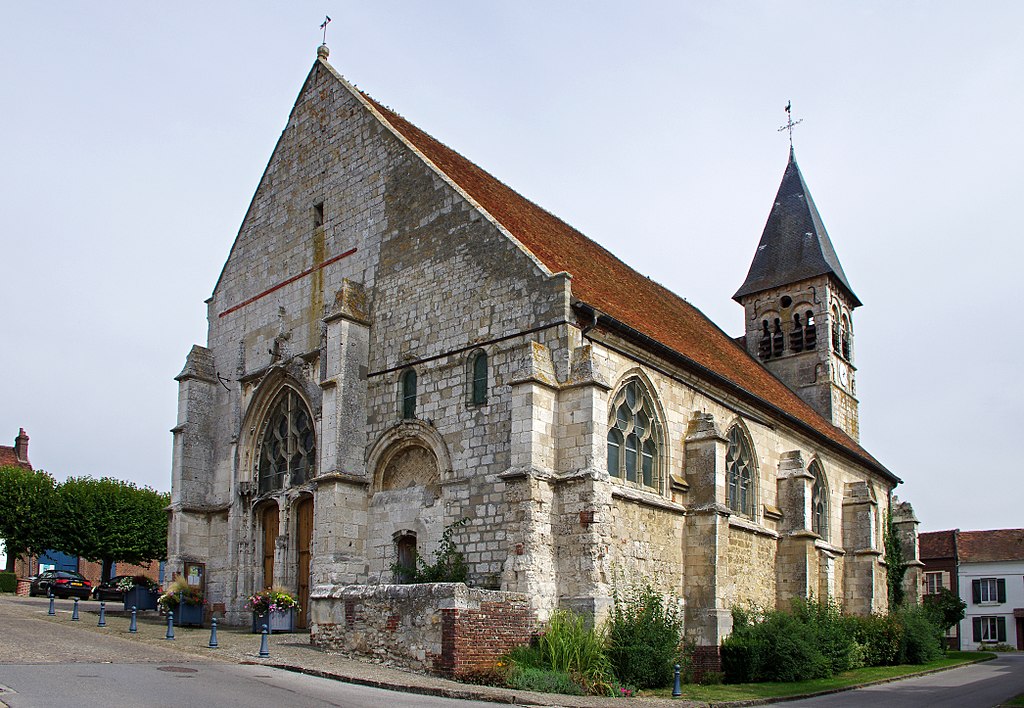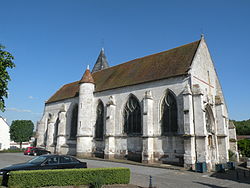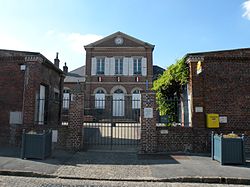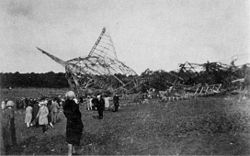Allonne (Oise) (9645528793)
Eglise Notre-Dame de l'Annonciation.
La construction de l'église a débuté au XIIe siècle et s'est terminée au XVIe siècle. Les styles roman et gothique coexistent donc.
"L'église est double , c'est-à-dire formée de deux vaisseaux juxtaposés dans le sens de leur longueur. Le premier édifice, placé du côté sud, datant de l'époque romane, est aujourd'hui un latéral de la nef plus récente. Il ne reste de cette construction primitive que le portail et le clocher."
"L'église primitive paraît dater du onzième siècle. Les parties récentes sont de la fin du quinzième ou du commencement du seizième siècle. Il est probable que l'édifice fut ruiné avec beaucoup d'autres , pendant le siège de Beauvais en 1472, et qu'on rétablit les parties détruites lorsqu'on éleva les transepts de la cathédrale; c'est du moins le même style."
"Le clergé de la cathédrale (de Beauvais) allait anciennement en procession à Allonne le jour de l'Annonciation. Lorsque le czar Pierre-le-Grand vint en France dans l'année 1717, il ne s'arrêta pas à Beauvais, quoiqu'en aient dit les écrivains modernes; mais il vint descendre à Allonne chez M. Auxcousteaux , conseiller au présidial qui lui offrit à dîner,". (PRÈCIS STATISTIQUE SUR LE CANTON DE BEAUVAIS, ARRONDISSEMENT DE BEAUVAIS (OISE). RÈDlGÉ EN 1851.) Louis Graves)
Church of Our Lady of the Annunciation.
The construction of the church began in the twelfth century and ended in the sixteenth century. Romanesque and Gothic styles co-exist
"The church is double, that is to say, consisting of two ships side by side in the direction of their length. The first building, located on the south side, dating from the Roman era, is today one of the side latest nave. All that remains of this primitive build the portal and the bell tower. "
"The early church seems to date from the eleventh century. Recent spaces at the end of the fifteenth or beginning of the sixteenth century. It is likely that the building was destroyed along with many others, during the siege of Beauvais in 1472, and we restored the destroyed parts when raised the transepts of the cathedral, which is at least the same style. "
"The cathedral clergy (Beauvais) was formerly in procession Allonne the day of the Annunciation. When Czar Peter the Great came to France in 1717 years, it did not stop in Beauvais but came to live in Allonne in the home of Mr. Auxcousteaux, presidial advisor who offered him to dinner."
(Accurate statistical ON TOWNSHIP Beauvais, Beauvais BOROUGH (OISE). RÈDlGÉ IN 1851.) Louis Graves)
Le Csar pour venir de Hollande avait choisi la voie de mer. Pierre Ier débarqua donc à Dunkerque. Il n'avait qu'une idée, arriver le plus rapidement possible à Paris. Il désirait le plus possible échapper au cérémonial.
A Beauvais, l’évêque-comte l’attendait à coucher. "J’avais, écrivait l’évêque avec mélancolie, rendu ma maison, qui n’est pas magnifique, le plus commode que j’avais pu pour loger le Tsar et une partie de sa suite. Je lui préparais un concert de voix et d’instrumens, et une illumination avec feu d’artifice. Il aurait trouvé ses armes en plusieurs endroits de sa maison et, dans la chambre où je croyais qu’il devait coucher, les portraits des grands-ducs de Moscovie, père et mère du Czar. Mais tous ces préparatifs, et tous ceux que j’avais tâché de faire pour lui donner à manger ont été inutiles." En effet le Tsar, redoutant l’affluence du peuple qui commençait à se presser sur son passage, ne voulut même pas entrer dans Beauvais, et, il préféra s’arrêter dans un méchant village, où lui et sa suite dînèrent au cabaret pour dix-huit francs. Comme on lui avait fait observer à l’avance qu’il ferait mauvaise chère dans ce cabaret : "Je suis un soldat, aurait-il répondu. Pourvu que je trouve du pain et de la bière, je suis content." (Visite du Tsar Pierre le Grand en 1717 d'après les documents nouveaux du Comte d'Haussonville - 1896 - Revue des Deux Mondes)
Tsar to come from Holland had chosen the path of Peter the sea therefore landed at Dunkirk. He had an idea, get as quickly as possible in Paris. He wanted as much as possible to escape the ceremony.
A Beauvais, Bishop-Count expected to host the Tsar. The bishop said: "I made my home, which is humble, the more convenient than I could, to accommodate the Tsar, and part of his entourage. I prepared him a chorus of voices and instruments, and an illumination with fireworks. He would have found his arms in several places in the house and in the room where I thought he was sleeping, the portraits of the Grand Dukes of Muscovy, father and mother of the Czar.
But all these preparations, and all that I had tried to do to feed him were useless. "
In fact, the Tsar, fearing the influx of people who began to hurry on his way, not even tried to enter Beauvais, and he preferred to stop a villain in town, where he and his entourage dined at the tavern for ten eight francs.
As was pointed out to him in advance that he would bad meal in this cabaret, he replied: "I am a soldier, provided I find bread and beer, I'm happy." (Visit of Tsar Peter the Great in 1717 after new documents Comte d'Haussonville - 1896 - Review of Two Worlds)Relevante Bilder
Relevante Artikel
Allonne (Oise)Allonne ist eine französische Gemeinde mit 1659 Einwohnern im Département Oise in der Region Hauts-de-France. Die Gemeinde liegt im Arrondissement Beauvais und ist Teil der Communauté d’agglomération du Beauvaisis und des Beauvais-2. .. weiterlesen





